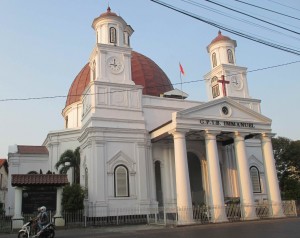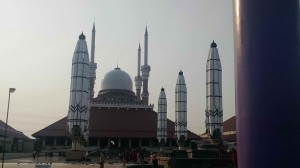Semarang

Joice and parents
Joice is a GC alum. When she was in Goshen she was at our house many times. She now lives in Semarang and we wanted to spend some time with her. We had a good lunch with her and her parents. They then showed us some of the sites of Semarang.
Semarang is on the north coast of Java about 1½ hour from Salatiga. It is the 6th largest city in Indonesia with about 2 million population. It was an important port during the Dutch colonial period and still is today. The Dutch took over the city in the late 1600s and were there until the Japanese occupied it 1942-1945. We stopped by the beach to view the sea.

Blenduk Church
The Immanuel Protestant Church of Western Indonesia (Gereja Protestan Indonesia Barat Immanuel), better known as Blenduk Church was built in 1753; it is the oldest church in the province. The church has a large copper dome from which it gets its name “Blenduk”, the Javanese word for “dome.” Inside there is still a large pipe organ, though it no longer works. There is a spiral staircase which leads to the second floor.
Lawang Sewu was built as the headquarters of the Dutch East Indies Railway Company. The name Lawang Sewu is Javanese and means “Thousand Doors”. The name comes from its design, with numerous doors and arcs. The building has about 600 large windows. The building was completed in 1907. When the Japanese took over Indonesia, they used the basement as a prison and execution area.
Sam Poo Kong is the oldest Chinese temple in Semarang. Originally established by the Chinese Muslim explorer Zheng He in the early 1400s, it is now shared by Indonesians of multiple religious denominations, including Muslims and Buddhists.

Great Mosque
The Great Mosque of Central Java was completed in 2006. There are three central buildings arranged in the shape of a U, with the domed mosque at the centre; all buildings have pitched, tiled roofs, while the central mosque has four minarets. The central roof resembles the roof of a “joglo”, the traditional Javanese house, and symbolizes the rising steps toward heaven or to gain God’s blessing. The long buildings forming the arms of the U house a library and auditorium. In the central courtyard are six large hydraulically operated umbrellas, inspired by the ones in Medina, which are used to protect worshipers; the six umbrellas represent the six tenets of Islam theology. At the open end of the U is a series of Arabic-style arches standing on 25 pillars, each representing one of the named prophets in Islam. Beyond the arches is an inscription on a 3.2-metre (10 ft) tall, 7.8 ton stone from Mount Merapi. Nearby is the 99-metre tall tower, designed to resemble the minaret of a mosque in Kudus and used to call Muslims to prayer. The whole complex is difficult to capture in photos. Photos on the web give a fairer view of the magnificent area!
In Semarang’s Chinatown Tay Kak Sie is another old Chinese temple. It was established in 1746 and accommodates worshippers from three religions: Buddhism, Confucianism and Taoism.
One last place we visited is the world’s largest Anabaptist church. It was completed in 2006 and holds 12,000 people. It will be the site of the Mennonite World Conference in 2021.
- Joice and parents
- coast
- Blenduk Church
- organ
- spiral staircase
- Lawang Sewu
- Lawang Sewu
- Sam Poo Kong complex
- temple area
- roof decorations
- statues
- temple area
- Great Mosque
- arches and pillars
- large Koran
- Great Mosque
- looking down from 2nd floor
- second floor
- “umbrellas”
- minaret
- Merapi rock
- Tay Kak Sie
- inside temple
- temple roof
- JKI church
- inside church
- auditorium



























